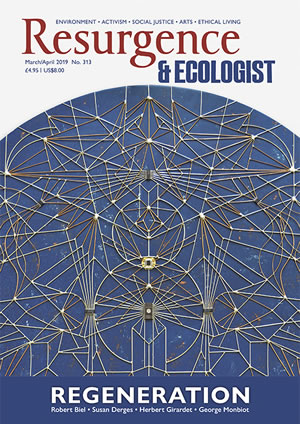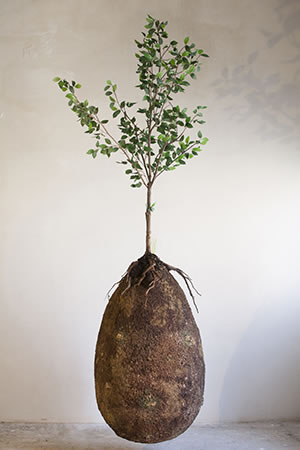“When I first started out with this and people asked what I did in a social situation, I really struggled with it, because I wanted to just say that I buried people in shallow graves in the woods,” says Rosie Inman-Cook, manager of The Natural Death Centre (NDC).
At that time very few people were aware of green or natural burial, or that it was feasible and legal. But that was nearly twenty years ago, when there were just 50 natural burial sites. Today, says Inman-Cook, there are well over 300.
There are effectively two types of natural burial ground in the UK, according to the NDC, which runs the Association of Natural Burial Grounds to ensure that sites are well run.
There are ‘deep green’ sites, where embalming is not allowed and bodies are placed in caskets made of biodegradable material such as wicker, or wrapped in a simple shroud. At the other end of the spectrum there are sites where a tree is planted but no other environmentally friendly rules apply. Settings can range from mown wild-flower meadows to woodland, field sites where new woodland is being established, or more manicured parkland.
The sites are run by landowners such as farmers, charitable trusts and non-profit organisations, and many local authorities are now setting aside parts of municipal cemeteries for this type of burial. However, Inman-Cook warns that some large companies have spotted the trend and set up burial grounds that are much more commercialised, so people should go and visit before booking.
Natural burials have several benefits for the environment over cremation or traditional burial in a cemetery, according to proponents of natural burial. Cremation uses fossil fuels to reduce a body to ash, and this is estimated to release more than 270,000 tonnes of CO2 annually in the US alone. It also releases particulates such as nitrogen oxide, and mercury from dental fillings, though some countries require crematoria to have filters to reduce these emissions. Formaldehyde used in embalming can also cause pollution.
Traditional burial also has a large footprint. The Green Burial Council, which certifies sites in the US, estimates that each year North Americans use 6 million metres of wood, 20 million litres of embalming fluids, 1.5 million tonnes of reinforced concrete, 15,000 tonnes of copper and bronze, and 58,500 tonnes of steel in traditional burials.
The natural burial movement has now spread around the world. In Europe, many countries have laws that currently prevent natural burial, but the Netherlands does not, and has seen a growth in the practice.
Joyce Sengers is the founder of De Utrecht Natural Burial Ground, one of around 15 such sites in the Netherlands. She cites various reasons for a trend towards natural burial, including the fall in churchgoing, meaning that there are many people looking for alternative ways to bury the dead. At the same time, the number of natural burial grounds is increasing as landowners look for other sources of income, she says.
The De Utrecht site is located on a former conifer plantation, and since it was set up around five years ago it has been transformed into a Nature reserve featuring moorland, wetlands, a shady wood, a light wood and a birch forest. Ceremonies can be held by a lake or on the edge of the birch forest.
“People like it, especially because it’s so simple and they don’t have to do grave maintenance,” says Sengers. “It’s also a nice place to visit – you don’t go to visit a two-square-metre plot where the body is: you go to the whole woodland, where you can go for a walk.”
Natural burial has also become popular in the US. Sites certified by the Green Burial Council have grown from one in 2006 to more than 300 today.
However, a not-for-profit organisation in Washington State is hoping to take the concept a step further with a completely new method of disposing of human remains. The concept was developed by architecture graduate Katrina Spade when she started thinking about what would happen to her body after she died, and was disappointed with the traditional options of burial and cremation, in terms of both the environmental impact and the lack of involvement of friends and family.
Spade was inspired by a method that has long been used to speed up the natural decomposition of deceased farm animals. Her organisation has developed a process known as recomposition, using the same principle to dispose of human remains. It is modelled on green burial, but is designed for cities where land is scarce.
In this process, the body would be placed in a vessel containing woodchips, alfalfa and straw, to which oxygen would be added to create the perfect environment for naturally occurring microbes and beneficial bacteria, Spade explains. After about 30 days, the body, including bones and teeth, would have broken down to create a nutrient-rich soil. The family could then use the soil to grow plants or trees, or it could be donated to conservation projects in nearby Puget Sound.
The ritual around death, which is “an incredible moment that we all share”, has been diluted by the traditional funeral industry, Spade believes. “Cremation is often very industrialised – it’s kind of a transactional practice. When you strip ritual from this really important event, it bolsters our denial of death. We push it to arm’s length.” At a facility run by Spade’s organisation Recompose, family and friends of the deceased could not only view the body, but also wash, shroud and prepare it for burial.
A bill to legalise recomposition is due to be considered by Washington State legislators this year. Spade is optimistic that it will pass, since residents in the state tend to be environmentally conscious and open to innovative ideas. In addition, there is awareness among politicians that a growing population needs more options, as burial space is limited.
Recompose is keen to help other areas follow suit, both in the US and worldwide, once the concept is up and running in Washington. The organisation has had enquiries from countries including Brazil, Mexico and Australia.
“Death is part of a beautiful natural cycle,” says Spade. “In a forest, organic material grows and then decomposes, and becomes the basis for all new life. That cycle is quite perfect – how practical and how beautiful to be able to create soil out of the dead.”








